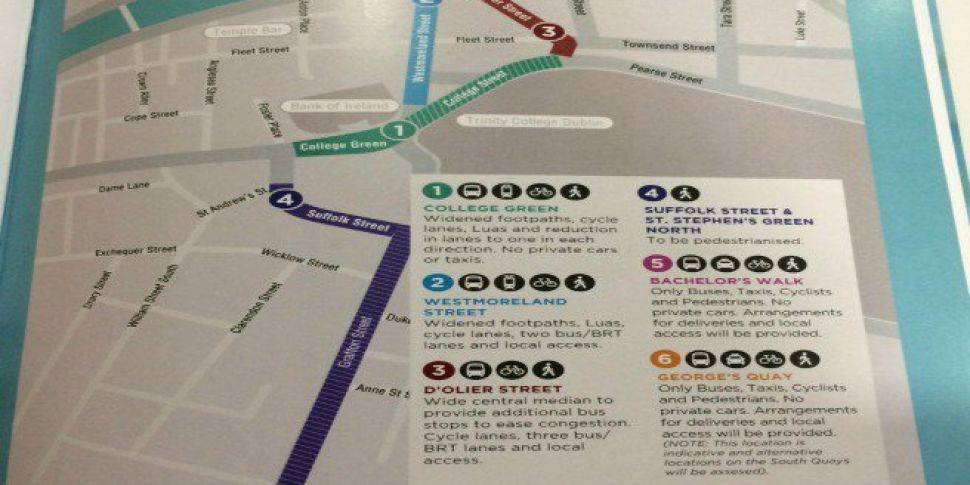Cars could be banned on Bachelors Walk, one of the South Quays, Westmoreland Street and College Green.
It's part of a plan by Dublin City Council and the National Transport Authority to make the city centre more bus, cycle and pedestrian friendly.
An extra 42 thousand peak journeys into town are anticipated by 2023.
People can have their say on the proposals until July 16th.
Measures proposed in the Dublin City Centre Transport Study include:
- A rebalancing of road space and junction capacity to enable increased public transport provision;
- the introduction of the high-capacity Bus Rapid Transit (BRT) system;
- increasing the frequency and capacity of the DART;
- running new rail passenger services between Kildare and the Grand Canal Dock area through the Phoenix Park Tunnel;
- enhancing interchange opportunities between modes at key points across the city;
- developing a high-quality cycle network in the City Centre;
- improving pedestrians’ experiences with wider footpaths and crossing priority at key junctions; and
- reorganising city centre space for taxis and for coach-parking.
Specifically, the Study proposes extending the current ‘bus gate’ at College Green to exclude cars, vans and taxis on a 24-hour basis, restricting the street permanently to Luas, buses, cyclists and pedestrians and developing a much-enhanced civic space in front of Trinity College.
On the North and South Quays, Bachelors’ Walk would be reconfigured as a public transport / cycling / walking only corridor, between its junctions with Jervis Street and O’Connell Street. Across the river, this arrangement would be mirrored, either on Aston Quay, Burgh Quay or George’s Quay – with this decision to be made following a more detailed analysis. General through-traffic would be re-routed around the city’s central area – freeing up road-space in this currently congested part of the city.
As a result of the new traffic restrictions on College Green, Westmoreland Street too would cease to be a through route for car traffic, and can therefore be reconfigured to provide a high quality pedestrian environment, linking the city centre’s two major retail/leisure destinations – O’Connell Street/Henry Street and the Grafton Street Quarter – with wider paths, priority pedestrian crossing onto O’Connell Bridge, BRT and Luas interchange and enhanced cycling facilities.
D’Olier Street would also benefit directly from car-traffic realignments in the city centre. A new central median to accommodate additional bus stops, segregated cycle lanes and ready access to the DART at Tara Street would make this street a key interchange location in the city.
Developing Luas Cross City has opened up the opportunity to pedestrianise Suffolk Street, complementing the Grafton Street commercial area. And a new civic space can be created on St Stephen’s Green North between the Dawson Street and Grafton Street junctions, and extending southwards onto St. Stephen’s Green West.
In addition, investments will be made in improving key transport interchange locations across the city – at Connolly Station / Busaras and Heuston Station as well as at Westmoreland Street / D’Olier Street as outlined above. Three new Dockland Bridges – including a new road-bridge linking Thorncastle Road (Ringsend) to Sir John Rogerson’s Quay, are proposed, as well as imaginative new ways to accommodate the requirement for coach-parking facilities and city centre taxi ranks.
Owen Keegan, Dublin City Council Chief Executive said: “Dublin City Council and the NTA are making these proposals because we cannot meet the expected growth in commuter traffic over the next decade through more car journeys. The city centre can only continue to function effectively if we offer those working and living in Dublin, as well as visitors, more choices in how they access and move around the capital. The proposals would also provide a better living and working environment for business, residents and visitors”
Anne Graham, CEO of the National Transport Authority said: “The National Transport Authority will be investing €150 million in these projects between now and 2023. Facing up to what’s needed, and taking some hard decisions now, will pay dividends for the city, and for the country as a whole, in the future. The plans set out in the Study will deliver a modern, functioning capital city, which addresses the requirements of its citizens, and of which we will all be very proud. ”
For the full report, a summary report and details on how to take part in the consultation see: www.dublincity.ie/TransportStudy














